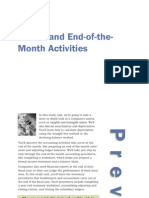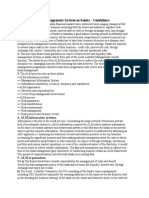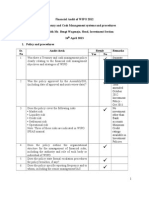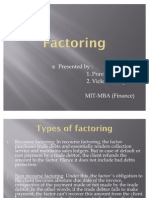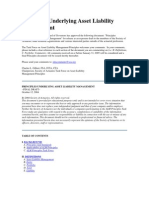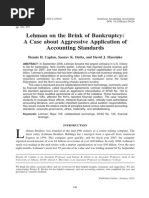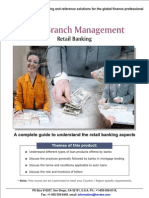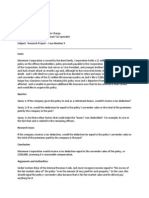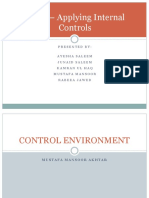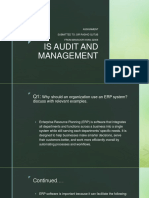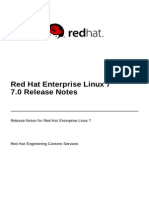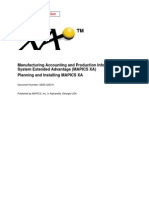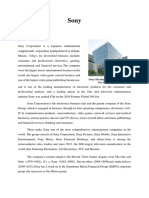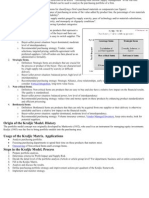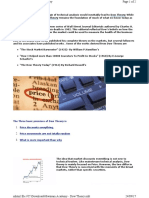BNY Mellon Resolution Plan
BNY Mellon Resolution Plan
Uploaded by
Mohan ArumugamCopyright:
Available Formats
BNY Mellon Resolution Plan
BNY Mellon Resolution Plan
Uploaded by
Mohan ArumugamOriginal Description:
Copyright
Available Formats
Share this document
Did you find this document useful?
Is this content inappropriate?
Copyright:
Available Formats
BNY Mellon Resolution Plan
BNY Mellon Resolution Plan
Uploaded by
Mohan ArumugamCopyright:
Available Formats
BNY MELLON Logo
BNY Mellon Resolution Plan Public Section October 1, 2013
Table of Contents Section 1: Public Section page 3
Introduction page 3 Entities Overview ofMaterial BNY Mellon page 5 A.Names of page 7 Regarding B.Description Core Business Lines page 8 page C.Summary ofof Financial Information Assets, Liabilities, Capital and Major Funding Sources 9 15 D.Description of Derivative and Hedging Activities E.Memberships in Material Payment, Clearing Settlement Systems page 17 F.Description of Foreign Operations page 18 and page G.Material Supervisory Authorities page 19 H.Principal Officers page 21 I.Resolution Planning Corporate Governance Structure and Processes J.Description Description of Material of Management Information Systems page 23 page 22 K.High-Level Resolution Strategy page 24
Section 1: Public Section
Introduction This Public Section provides an overview of the overall resolution strategy for The Bank of New York Mellon Corporation and its material entities, including its principal bank subsidiary, The Bank of New York Mellon. References to "our," "we," "us," and "BNY Mellon," refer to The Bank of New York Mellon Corporation and its consolidated subsidiaries, while references to the "Parent" refer solely to The Bank of New York Mellon Corporation, the parent company. Title I, Section 165(d) of the Dodd-Frank Wall Street Reform and Consumer Protection Act (the "DoddFrank Act") and implementing regulations issued by the Federal Deposit Insurance Corporation (the "FDIC") and the Board of Governors of the Federal Reserve System (the "Federal Reserve") require bank holding companies with assets of $50 billion or more, such as the Parent, to submit periodically to the Federal Reserve, the FDIC and the Financial Stability Oversight Council a plan for resolution in the event of material distress or failure of the bank holding company. The FDIC has also issued a final rule that requires insured depository institutions with assets of $50 billion or more, such as The Bank of New York Mellon, to submit periodically to the FDIC a plan for resolution in the event of failure under the Federal Deposit Insurance Act (the "FDI Act"). Accordingly, we have developed a resolution plan in conformity with both rules (the "Resolution Plan"), including this Public Section which contains the information required by the regulators to be made available publicly. BNY Mellon supports the regulatory reform efforts implemented since the financial crisis to mitigate systemic risk and improve global financial stability. BNY Mellon believes no firm should be "too big to fail" and that, regardless of size, financial institutions should be able to be resolved without taxpayer or U.S. government support. BNY Mellon endorses the concept of resolution planning as a key element of risk management to protect the soundness of the global financial system. BNY Mellon has a strong balance sheet in terms of capital, liquidity and asset quality. Our model is primarily fee-based with no substantial exposure to credit risk. A large percentage of our revenuemore than the median revenue of our peerscomes from recurring fees. This helps BNY Mellon maintain a strong, highly liquid balance sheet with a solid capital position and strong credit ratings. As required by supervisory guidance, the Resolution Plan considers strategies for the resolution of BNY Mellon in the event of an idiosyncratic event that causes material financial distress or failure, and assumes that this idiosyncratic event may occur at a time when general macroeconomic conditions are consistent with either baseline, adverse or severely adverse economic scenarios. The Resolution Plan sets out a detailed description of the resolution options for the Parent and each of its material entities, including The Bank of New York Mellon, with a focus on ensuring their orderly resolution in a manner that preserves value, ensures continuity of services, and avoids systemic risk to the U.S. financial system. In each of the resolution strategies, depositors would have timely access to their insured deposits and there would be no cost to the FDIC Deposit Insurance Fund.
In the unlikely event a resolution of BNY Mellon were necessary, there are several factors that contribute to the resolvability of BNY Mellon under the U.S. Bankruptcy Code and other applicable insolvency regimes, including the facts that (i) the bulk of BNY Mellon's core business lines and critical operations are conducted in The Bank of New York Mellon, which would allow the FDIC to use its traditional resolution powers in receivership under the FDI Act to facilitate the orderly disposition or wind down of The Bank of New York Mellon, (ii) the core business lines and critical operations conducted through non-bank entities of BNY Mellon are largely self-contained within separate legal entities, allowing for their rapid divestiture or orderly wind-down, if necessary, under the U.S. Bankruptcy Code, and (iii) our highly liquid balance sheet would allow us to withstand deposit run-off without systemic impact. While BNY Mellon could similarly be resolved without systemic impact under the Orderly Liquidation Authority of Title II of the Dodd-Frank Act, pursuant to which the FDIC is granted the power and authority to resolve systemically important financial institutions in a manner analogous to the resolution of failed insured depository institutions under the FDI Act, the Dodd-Frank Act implementing regulations specifically require the Resolution Plan to provide a strategic analysis of resolvability under the U.S. Bankruptcy Code and certain other applicable insolvency regimes. Accordingly, the Orderly Liquidation Authority is outside the scope of the Resolution Plan. The information contained in the Resolution Plan, including this Public Section, has been prepared in accordance with applicable regulatory requirements and guidance. Any differences in the presentation of information concerning our businesses and operations contained herein relative to how BNY Mellon presents such information for other purposes is solely due to our efforts to comply with the rules governing the submission of resolution plans. The information presented herein, including the designation of "material entities" and "core business lines", does not, in any way, reflect changes to our organizational structure, business practices or strategy.
Overview of BNY Mellon The Bank of New York Mellon Corporation, a Delaware corporation (NYSE symbol: BK), is a global investments company dedicated to helping its clients manage and service their financial assets throughout the investment lifecycle. Whether providing financial services for institutions, corporations or individual investors, BNY Mellon delivers informed investment management and investment services in 35 countries and more than 100 markets. We were formed as a bank holding company and have our executive offices in New York, New York. With its predecessors, BNY Mellon has been in business since 1784. Our two principal banks are: The Bank of New York Mellon, a New York state chartered bank, which houses our Investment Services businesses, including Asset Servicing, Issuer Services, Treasury Services, Broker-Dealer and Advisor Services as well as the bank-advised business of Asset Management; and BNY Mellon, National Association, a nationally-chartered bank, which houses our Wealth Management business.
Our two principal U.S. banks engage in trust and custody activities, investment management services, banking services and various securities-related activities. We have four other U.S. bank and/or trust companies concentrating on trust products and services across the United States: The Bank of New York Mellon Trust Company, National Association, BNY Mellon Trust of Delaware, BNY Mellon Investment Servicing Trust Company and BNY Mellon Trust Company of Illinois. Most of our asset management businesses, along with our Pershing businesses, are direct or indirect non-bank subsidiaries of BNY Mellon. We divide our businesses into two principal segments, Investment Management and Investment Services. Our Investment Management business is comprised of our affiliated investment management boutiques, wealth management business and global distribution companies. Our Investment Management business is responsible, through various subsidiaries, for U.S. and non-U.S. retail, intermediary and institutional investment management, distribution and related services. The investment management boutiques offer a broad range of equity, fixed income, cash and alternative/overlay products. We are one of the world's largest asset managers with a top-10 position in the U.S., Europe and globally. Through BNY Mellon Wealth Management, we offer a full array of investment management, wealth and estate planning and private banking solutions to help clients protect, grow and transfer their wealth through an extensive network of offices in the U.S., Canada, UK and Asia. Clients include high-net-worth individuals and families, charitable gift programs, endowments and foundations and related entities. Our Investment Services business provides global custody and related services, collateral services, alternative investment services, corporate trust and depositary receipt services, as well as clearing
services and global payment/working capital solutions to institutional clients. Our clients include corporations, public funds and government agencies, foundations and endowments; global financial institutions including banks, broker-dealers, asset managers, insurance companies and central banks; financial intermediaries and independent registered investment advisors and hedge fund managers. We help our clients service their financial assets through a network of offices and operations centers in 35 countries across six continents. Additional information related to BNY Mellon is contained in BNY Mellon's reports filed with the Securities and Exchange Commission (the "SEC"), including our Annual Report on Form 10-K for the year ended December 31, 2012 (which contains the Annual Report to Shareholders (the "2012 Annual Report") included with the 10-K) (the "2012 Form 10-K"), the Quarterly Reports on Form 10-Q and the Current Reports on Form 8-K (each, a "'34 Act Report"). These '34 Act Reports can be viewed, as they become available, on the SEC's website at www.sec.gov and at www.bnymellon.com. Information contained in '34 Act Reports that BNY Mellon makes with the SEC subsequent to the date of filings referenced in this document, including the 2012 Form 10-K, may modify, update and supersede such information contained in this document. Unless otherwise indicated, the information in this document concerning BNY Mellon's assets, liabilities, capital and funding sources contained in Section C below has been extracted from the 2012 Annual Report. Such information speaks only as of the date of the 2012 Annual Report. Unless otherwise indicated, all other information is as set forth in our quarterly report on Form 10-Q for the period ended June 30, 2012. This document and BNY Mellon's '34 Act Reports referred to above contain forward-looking statements
within the meaning of the Private Securities Litigation Reform Act of 1995. Words such as "estimate," "forecast," "project," "anticipate," "confident," "target," "expect," "intend," "seek," "believe," "plan," "goal," "could," "should," "may," "will," "strategy," "opportunities," "trends" and words of similar meaning, signify forward-looking statements. These statements are based on the current beliefs and expectations of BNY Mellon's management and are subject to significant risks and uncertainties that are subject to change based on various important factors (some of which are beyond BNY Mellon's control). Actual results may differ materially from those set forth in the forward-looking statements. Factors that could cause BNY Mellon's actual results to differ materially from those described in the forward-looking statements can be found in the "Risk Factors" section of the 2012 Form 10-K and Quarterly Reports on Form 10-Q filed with the SEC. All forward-looking statements speak only as of the date on which such statements are made and BNY Mellon does not undertake to update the forward-looking statements to reflect the impact of circumstances or events that may arise after the date of the forward-looking statements.
A. Names of Material Entities The following list of BNY Mellon entities includes the covered company and the subsidiaries and foreign offices that are deemed "material entities" (Footnote 1. For purposes of resolution plans required under Section 165(d) of the Dodd-Frank Act ("SIFI Plan"), a "material entity" is defined as: "...a subsidiary or foreign office of the covered company that is significant to the activities of a critical operation or core business line." 12 CFR Part 243 (Federal Reserve) or 12 CFR Part 381 (FDIC). For purposes of resolution plans required for insured depository institutions with assets of $50 billion or more ("IDI Plan"), a "material entity" is defined as: ".a company that is significant to the activities of a critical service or core business line." 12 CFR Part 360 (FDIC). End footnote.) for purposes of the Resolution Plan: BNY Investment Management Services LLC BNY Mellon International Operations (India) Private Limited BNY Mellon Investment Servicing (US) Inc. iNautix Technologies India Private Limited MBSC Securities Corporation Pershing LLC Technology Services Group, Inc. Tennessee Processing Center LLC The Bank of New York Mellon The Bank of New York MellonBrussels Branch The Bank of New York MellonLondon Branch The Bank of New York Mellon Corporation The Bank of New York Mellon SA/NV The Bank of New York Mellon Trust Company, N.A. The Dreyfus Corporation
B. Description of Core Business Lines The following businesses are deemed "core business lines" (Footnote 2. For purposes of SIFI Plans, "core business lines" are defined as: "...those business lines of the covered company, including associated operations, services, functions and support that, in the view of the covered company, upon failure would result in a material loss of revenue, profit or franchise value." 12 CFR Part 243 (Federal Reserve) or 12 CFR Part 381 (FDIC). For purposes of IDI Plans, "core business lines" are defined as: ".those business lines of the [covered insured depository institution], including associated operations, services, functions and support that, in the view of the [covered insured depository institution], upon failure would result in a material loss of revenue, profitorfranchisevalue."12CFRPart360(FDIC).Endfootnote.)for purposes of the Resolution Plan: Asset Servicing
BNY Mellon Asset Servicing offers clients worldwide a broad spectrum of specialized asset servicing capabilities, including custody and fund services, performance and analytics, and execution services. BNY Mellon is the largest custodian for U.S. corporate and public pension plans and services 46% of the top 50 endowments. We are a leading custodian in the UK and service 20% of UK pensions that require a custodian. Corporate Trust BNY Mellon is the leading provider of corporate trust services for all major conventional and structured finance categories, and a leading provider of specialty services. Clearing debt Services Pershing, our clearing service, provides business solutions to approximately 1,600 financial organizations globally by delivering dependable operational support; robust trading services; flexible technology; an expansive array of investment solutions, practice management support and service excellence. Asset Management Our asset management business is comprised of our affiliated investment management boutiques. Our asset management business is responsible, through various subsidiaries, for U.S. and non U.S. retail, intermediary and institutional investment management, distribution and related services. The investment management boutiques offer a broad range of equity, fixed income, cash and alternative/overlay products. We are one of the world's largest asset managers with a top-10 position in the U.S., Europe and globally. Additional information related to BNY Mellon's businesses is contained in BNY Mellon's reports filed with the SEC, including the 2012 Form 10-K, the Quarterly Reports on Form 10-Q and the Current Reports on Form 8-K, available at www.bnymellon.com.
C. Summary of Financial Information Regarding Assets, Liabilities, Capital and Major Funding Sources The table below provides a consolidated balance sheet for The Bank of New York Mellon Corporation as of December 31, 2012. (dollar amounts in millions, except per share amounts) Heading rowrow column 1 Category: Amount:$4,727 Column 2: Amount: end heading Assets:Cash and due other from:Banks from:Interest-bearing deposits with Federal Reserve and central banks Amount:90,110 Assets:Cash and due from:Interest-bearing depositsfunds with the banks Amount:43,910 Assets:Cash and due from:Federal sold and securities purchased under resale agreements Assets:Securities:Held-to-maturity (fair valueAmount:6,593 of $8,389) Amount:8,205 Assets:Securities:Available-for-sale Amount:92,619 Assets:Securities:Total securities Amount:100,824 Assets:Securities:Trading assets Amount:9,378 Assets:Securities:Loans Amount:46,629 Assets:Securities:Allowance forequipment loan losses Amount:(266) Assets:Securities:Net loansinterest Amount:46,363 Assets:Securities:Premises and Amount:1,659 Assets:Securities:Accrued receivable Amount:593 Assets:Securities:Goodwill Amount:18,075 Assets:Securities:Intangible assets Amount:4,809 Assets:Securities:Other assets (includes $1,299 at fair value) Amount:20,468 Assets:Securities:Subtotal assets of operations Amount:347,509 Assets:Assets of consolidated investment management funds, at fair value:Trading assets Amount:10,961 Assets:Assets of consolidated investment management funds, at fair value:Other assets Amount:520 Assets:Assets of consolidated investment management funds, at fair value:Subtotal assets of consolidated investment management funds, at fair value Amount:11,481 Assets:Assets of consolidated investment management funds, at fair value:Total assets Amount:$358,990 Liabilities:Deposits:Noninterest-bearing (principally U.S. offices) Amount:$93,019 Liabilities:Deposits:Interest-bearing deposits in U.S. offices Amount:53,826 Liabilities:Deposits:Noninterest-bearing deposits in Non-U.S. offices Amount:99,250 Liabilities:Deposits:Total deposits Amount:246,095 Liabilities:Deposits:Federal funds purchased and securities sold under repurchase agreements Amount:7,427 Liabilities:Deposits:Trading liabilities Amount:8,176 Liabilities:Deposits:Payables to customers and broker-dealers Amount:16,095 Liabilities:Deposits:Commercial paperAmount:7,316 Amount:338 Liabilities:Deposits:Other borrowed funds Amount:1,380 Liabilities:Deposits:Accrued taxes and other expenses Liabilities:Deposits:Other liabilities (including allowance forfair value) lending-related commitments of $121, also includes $578 at Amount:6,010 Liabilities:Deposits:Long-term debt (includes $345 at fair value) Amount:18,530 Liabilities:Deposits:Subtotal liabilities of operations Amount:311,367 Liabilities:Liabilities of consolidated investment management funds, at fair value: Liabilities:Liabilities of consolidated investment management funds, atof fair value:Trading liabilities Amount:10,152 Liabilities:Liabilities consolidated investment management funds, at fair value:Other liabilities Amount:29 Liabilities:Liabilities of consolidated investment management at of consolidated investment management funds, atliabilities fair value Amount:10,0181 Liabilities:Liabilities of consolidated investment management funds, funds, at fair fair value:Subtotal value:Total liabilities Amount:321,548
Heading row column 1 Category Column 2: Amount: end heading 178 row Temporary equity:Redeemable noncontrolling interests Amount: Permanent equity:Preferred stock - par par value value $0.01 per share; authorized preferred issued 10,826 shares Amount: Permanent 100,000,000 equity:Common stock -shares; $0.01 per share; authorized 3,500,000,000 common shares; issued 1,254,182,209 shares Amount: 13 1,068 Permanent equity:Additional paid-in capital Amount: 23,485 equity:Retained earnings Amount: 14,622 Permanent equity:Accumulated other comprehensive loss, net of tax Amount: (643) Permanent equity:Less: Treasury stock of 90,691,868 common shares, at cost Amount: (2,114) Permanent equity:Total The Bank of New York Mellon Corporation shareholders' equity Amount: 36,431 Permanent equity:Non-redeemable noncontrolling interests of consolidated investmentpermanent management funds Amount: 833 Permanent equity:Total equity Amount: liabilities, temporary equity 37,264 and permanent equity Amount: $358,990
(dollar amounts in millions, except per share amounts)
Source: 2012 Annual Report.
The table below provides a consolidated balance sheet for The Bank of New York Mellon as of December 31, 2012.
(dollar amounts in millions)
Heading rowand columnbalances 1 Category 2: Amount: end heading row Assets:Cash from institutions: Noninterest-bearing andColumn currency and coin Amount: $3,356 Assets:Cash and due due from depository depository institutions:Interest-bearing balances Amount: 124,155 Assets:Securities:Held-to-maturity securities Amount: 8,205 Assets:Securities:Available-for-sale securities Amount: 88,405 Assets:Securities:Federal funds sold and securities purchased under agreements to resell: Assets:Securities:Federal funds sold in under domestic offices Amount: 17 27,994 Assets:Securities:Securities purchased agreements to resell Amount: 1,290 Assets:Securities:Loans and lease financing receivables: Assets:Securities:Loans and leases held for sale Amount: 0 Assets:Securities:Less: Allowance for loan and lease losses Amount: 243 Assets:Securities:Loans and leases, net of unearned income and allowance Amount: 27,751 Assets:Securities:Trading Amount: 4,936 leases) Assets:Securities:Premises and fixed assets (including capitalized Amount: 1,198 realassets estate owned Amount: 4 Assets:Securities:Investments in unconsolidated subsidiaries andAssets:Securities:Other associated companies Amount: 1,049 Assets:Securities:Direct and indirect investments in real estate Amount: 0 Assets:Intangible assets:Goodwill Amount: 6,443 Assets:Intangible assets:Other intangible assets Amount: 1,454ventures Assets:Intangible assets:Other assets Amount: 14,180 Assets:Intangible assets:Total assets Amount: $282,443 Liabilities:Deposits:In domestic offices Amount: $129,296 Liabilities:Deposits:Noninterest-bearing Amount: 85,272 Liabilities:Deposits:Interest-bearing Amount: 44,024 Liabilities:Deposits:In foreign offices, Edge and Agreement subsidiaries, and IBFs Amount: 110,151 Liabilities:Deposits:Noninterest-bearing Amount: 8,212 Liabilities:Deposits:Interest-bearing Amount: 101,939
(dollar amounts in millions)
Heading row column 1 Federal category Column 2: Amount: end heading row Liabilities Continued: funds purchased and securities sold under agreements to repurchase:Federal funds in domestic offices Amount:2,224 Liabilities Continued: Federal funds purchased and securities sold under agreements to repurchase:Securities soldpurchased under agreements to repurchase Amount:1,030 Liabilities Continued: Federal funds purchased and securities sold under agreements to repurchase:Trading liabilities Amount:6,967 Liabilities Continued: Federal funds purchased and securities sold under agreements to repurchase:Other borrowed money (includes mortgage indebtedness and obligations under capitalized leases) Amount:2,740 Liabilities Continued: Federal funds purchased and securities sold under agreements to repurchase:Subordinated notes and debentures Amount:1,065 Liabilities Federal funds purchased and sold agreements to liabilities Amount:8,917 Liabilities - Continued: Continued: Federal funds purchased and securities securities sold under under agreements to repurchase:Other repurchase:Total liabilities Amount:262,390 Capital:Perpetual preferred stock and related surplus Amount:0 Equity Capital:Common stock Amount:1,135 Capital:Surplus (excludes all surplus related to preferred stock)Amount:9,725 Equity Capital:Retained earnings Amount:9,273 Capital:Accumulated other comprehensive income Amount:(430) Capital:Other equity capital components Amount:0 Equity Capital:Total bank equity capital Amount:19,703 Capital:Noncontrolling (minority) interests in consolidated subsidiaries Amount:350 Equity Capital:Total equity capital Amount:20,053 liabilities and equity capital Amount:$282,443
Source: FFIEC Call Report, December 2012.
Capital
The table below provides capital ratios for BNY Mellon and The Bank of New York Mellon as of December 31, 2012. Heading row column 1 category Column 2: Amount: end heading row Consolidated and largest bank subsidiary capital ratios:Consolidated capital ratios:Estimated Basel III Tier common equity ratio -rule. Non-GAAP (Footnote(a). The estimated Basel III 1 Tier 1 common equity ratio at Dec 31, 2012 was based on the NPRs and final market risk Footnote (b). See "Supplemental Information Explanation of Non-GAAP financial measures" beginning on page 106 of our 2012 Annual Report for a calculation of this ratio. End footnotes) Amount:9.8% Consolidated and largest bank subsidiary capital ratios:Consolidated capital ratios:Determined under Basel I-based guidelines (c): Consolidated and 1 largest bank subsidiary capital ratios:Consolidated capital ratios:Tier common equity to risk-weighted assets ratio Non-GAAP(Footnote(b)) Amount:13.5% Consolidated and largest bank subsidiary capital ratios:Consolidated capital ratios:Tier 1 capital Amount:15.0 Consolidated and largest bank subsidiary capital ratios:Consolidated capital ratios:Total capital Amount:16.3 Consolidated and largest bank subsidiary capital ratios:Consolidated capital ratios:Leverage - guideline The Bank of New capital ratios (Footnote (c). When we refer toYork BNY Mellon Mellon's orAmount:5.3 our bank subsidiary's "Basel I" capital measures Basel I Total capital or Basel I Tier 1 capital), we mean Total or(e.g., Tierrisk-based 1 capital, as applicable, as calculated under the Federal Reserve's capital guidelines that are based on as the 1988 I" Basel which is often referred to "Basel End Accord, footnote):Tier 1 capital Amount:14.0% ratios:Total capital Amount:14.6 The Bank of New York Mellon capital ratios:Leverage Amount:5.4
Source: 2012 Annual Report.
As of December 31, 2012, BNY Mellon and our bank subsidiaries were considered "well capitalized" on the basis of the Basel I Total and Tier 1 capital to risk-weighted assets ratios and the leverage ratio (Basel I Tier 1 capital to quarterly average assets as defined for regulatory purposes). At December 31, 2012,
the amounts of capital by which BNY Mellon and our largest bank subsidiary, The Bank of New York Mellon, exceed the "well capitalized" guidelines are as follows: Heading row column (inBNY millions) column 2:BNY Mellon column 3:The Bank of1New York Mellon end heading row (consolidated) (in millions):Tier 1 capital Mellon (consolidated):$10,023 The Bank of New York Mellon:$7,745 (in millions):Total capital BNY Mellon (consolidated):7,023 The Bank Mellon:4,461 (in millions):Leverage BNY Mellon (consolidated): 930 The Bank of of New New York York Mellon:932
Source: 2012 Annual Report.
The Basel I Tier 1 capital ratio varies depending on the size of the balance sheet at quarter-end and the level and types of investments. The balance sheet size fluctuates from quarter to quarter based on levels of customer and market activity. In general, when servicing clients are more actively trading securities, deposit balances and the balance sheet as a whole is higher. In addition, when markets experience significant volatility or stress, our balance sheet size may increase considerably as client deposit levels increase.
Economic Capital
BNY Mellon has implemented a methodology to quantify economic capital. We define economic capital as the capital required to protect against unexpected economic losses over a one-year period at a level consistent with the solvency of a firm with a target debt rating. We quantify economic capital requirements for the risks inherent in our business activities using statistical modeling techniques and then aggregate them at the consolidated level. A capital reduction, or diversification benefit, is applied to reflect the unlikely event of experiencing an extremely large loss in each type of risk at the same time. Economic capital requirements are directly related to our risk profile. As such, it has become a part of our internal capital adequacy assessment process and, along with regulatory capital, is a key component to ensuring that the actual level of capital is commensurate with our risk profile, and is sufficient to provide the financial flexibility to undertake future strategic business initiatives. The framework and methodologies to quantify each of our risk types have been developed by BNY Mellon's Enterprise Risk Architecture Group and are designed to be consistent with our risk management principles. The framework has been approved by senior management and has been reviewed by the Risk Committee of the Board of Directors. Due to the evolving nature of quantification techniques, we expect to continue to refine the methodologies used to estimate our economic capital requirements.
Stress Testing
It is the policy of BNY Mellon to perform Enterprise-wide Stress Testing at regular intervals as part of its Internal Capital Adequacy Assessment Process ("ICAAP"). Additionally, BNY Mellon performs an analysis of capital adequacy in a stressed environment in its Enterprise-Wide Stress Test Framework, as required by the enhanced prudential standards issued pursuant to the Dodd-Frank Act. Enterprise-Wide Stress Testing performs analysis across BNY Mellon's lines of business, products, geographic areas, and risk types incorporating the results from the different underlying models and projections given a certain stress test scenario. It is an important component of assessing the adequacy of capital (as in the ICAAP) as well as identifying any high risk touch points in business activities.
Furthermore, by integrating enterprise-wide stress testing into BNY Mellon's capital planning process, the results provide a forward-looking evaluation of the ability to complete planned capital actions in a more-adverse-than-anticipated economic environment. Funding and Liquidity We fund ourselves primarily through deposits and, to a lesser extent, other borrowings, which are comprised of federal funds purchased and securities sold under repurchase agreements, payables to customers and broker-dealers, commercial paper, other borrowed funds and long-term debt. Certain other borrowings, for example, securities sold under repurchase agreements, require the delivery of securities as collateral. BNY Mellon defines liquidity as the ability of the Parent and its subsidiaries to access funding or convert assets to cash quickly and efficiently, especially during periods of market stress. Liquidity risk is the risk that BNY Mellon cannot meet its cash and collateral obligations at a reasonable cost for both expected and unexpected cash flows, without adversely affecting daily operations or financial conditions. Liquidity risk can arise from cash flow mismatches, market constraints from inability to convert assets to cash, inability to raise cash in the markets, deposit run-off or contingent liquidity events. Our overall approach to liquidity management is to ensure that sources of liquidity are sufficient in amount and diversity such that changes in funding requirements at the Parent and at the various bank subsidiaries can be accommodated routinely without material adverse impact on earnings, daily operations or our financial condition. BNY Mellon seeks to maintain an adequate liquidity cushion in both normal and stressed environments and seeks to diversify funding sources by line of business, customer and market segment. Additionally, we seek to maintain liquidity ratios within approved limits and liquidity risk tolerance; maintain a liquid asset buffer that can be liquidated, financed and/or pledged as necessary; and control the levels and sources of wholesale funds. Potential uses of liquidity include withdrawals of customer deposits and client drawdowns on unfunded credit or liquidity facilities. We actively monitor unfunded lending-related commitments, thereby reducing unanticipated funding requirements. When monitoring liquidity, we evaluate multiple metrics in order to have ample liquidity for expected and unexpected events. Metrics include cashflow mismatches, asset maturities, access to debt and money markets, debt spreads, peer ratios, liquid assets, unencumbered collateral, funding sources and balance sheet liquidity ratios. We monitor the Basel III liquidity coverage ratio as applied to us, based on our current interpretation of Basel III. Ratios we currently monitor as part of our standard analysis include total loans as a percentage of total deposits, deposits as a percentage of total interest-earning assets, foreign deposits as a percentage of total interest-earning assets, purchased funds as a percentage of total interest-earning assets, liquid assets as a percentage of total interest-earning assets, liquid assets as a percentage of purchased funds, and discount window collateral and central bank deposits as a percentage of total deposits. All of these ratios exceeded our minimum guidelines at December 31, 2012.
We also perform liquidity stress tests to ensure BNY Mellon maintains sufficient liquidity resources under multiple stress scenarios. Additional information related to BNY Mellon's assets, liabilities, capital and major funding sources is contained in BNY Mellon's reports filed with the SEC, including the 2012 Form 10-K, the Quarterly Reports on Form 10-Q and the Current Reports on Form 8-K, available at www.bnymellon.com.
D. Description of Derivative and Hedging Activities We use derivatives to manage exposure to market risk, interest rate risk, credit risk and foreign currency risk. Hedging derivatives
We utilize interest rate swap agreements to manage our exposure to interest rate fluctuations. For hedges of available-for-sale investment securities, deposits and long-term debt, the hedge documentation specifies the terms of the hedged items and the interest rate swaps and indicates that the derivative is hedging a fixed rate item and is a fair value hedge, that the hedge exposure is to the changes in the fair value of the hedged item due to changes in benchmark interest rates, and that the strategy is to eliminate fair value variability by converting fixed-rate interest payments to LIBOR. The available-for-sale investment securities hedged consist of sovereign debt and U.S. Treasury bonds that had original maturities of 30 years or less at initial purchase. The swaps on the sovereign debt and U.S. Treasury bonds are not callable. All of these securities are hedged with "pay fixed rate, receive variable rate" swaps of similar maturity, repricing and fixed rate coupon. The hedged fixed rate deposits have original maturities of approximately ten years and are not callable. These deposits are hedged with "receive fixed rate, pay variable" rate swaps of similar maturity, repricing and fixed rate coupon. The swaps are not callable. The fixed rate long-term debt instruments hedged generally have original maturities of five to 30 years. We issue both callable and non-callable debt. The non-callable debt is hedged with simple interest rate swaps similar to those described for deposits. Callable debt is hedged with callable swaps where the call dates of the swaps exactly match the call dates of the debt. In addition, we enter into foreign exchange hedges. We use forward foreign exchange contracts with maturities of nine months or less to hedge our British Pound, Euro and Indian Rupee foreign exchange exposure with respect to foreign currency forecasted revenue and expense transactions in entities that have the U.S. dollar as their functional currency. We use forward foreign exchange contracts with remaining maturities of nine months or less as hedges against our foreign exchange exposure to Australian Dollar, Euro, Swedish Krona, British Pound, Norwegian Krone and Japanese Yen with respect to interest bearing deposits with banks and their associated forecasted interest revenue. These hedges are designated as cash flow hedges. These hedges are effected such that their maturities and notional values match those of the deposits with banks. Forward foreign exchange contracts are also used to hedge the value of our net investments in foreign subsidiaries. These forward foreign exchange contracts usually have maturities of less than two years. The derivatives employed are designated as hedges of changes in value of our foreign investments due to exchange rates. Changes in the value of the forward foreign exchange contracts offset the changes in value of the foreign investments due to changes in foreign exchange rates.
Trading activities (including
trading
derivatives)
BNY Mellon provides a client-driven market making capability for interest rate and equity derivatives. We manage trading risk through a system of position limits, a VaR methodology based on Monte Carlo simulations, stop loss advisory triggers, and other market sensitivity measures. Risk is monitored and reported to senior management by a separate unit on a daily basis. Based on certain assumptions, the VaR methodology is designed to capture the potential overnight pre-tax dollar loss from adverse changes in fair values of all trading positions. The calculation assumes a one-day holding period for most instruments, utilizes a 99% confidence level, and incorporates the non-linear characteristics of options. The VaR model is one of several statistical models used to develop economic capital results, which is allocated to lines of business for computing risk-adjusted performance. As the VaR methodology does not evaluate risk attributable to extraordinary financial, economic or other occurrences, the risk assessment process includes a number of stress scenarios based upon the risk factors in the portfolio and management's assessment of market conditions. Additional stress scenarios based upon historic market events are also performed. Stress tests, by their design, incorporate the impact of reduced liquidity and the breakdown of observed correlations. The results of these stress tests are reviewed weekly with senior management. Counterparty credit risk and collateral
We assess credit risk of our counterparties through regular examination of their financial statements, confidential communication with the management of those counterparties and regular monitoring of publicly available credit rating information. This and other information is used to develop proprietary credit rating metrics used to assess credit quality. Collateral requirements are determined after a comprehensive review of the credit quality of each counterparty. Collateral is generally held or pledged in the form of cash or highly liquid government securities. Collateral requirements are monitored and adjusted daily. Additional information related to BNY Mellon's use of derivative instruments is contained in BNY Mellon's reports filed with the SEC, including the 2012 Form 10-K, the Quarterly Reports on Form 10-Q and the Current Reports on Form 8-K, available at www.bnymellon.com.
E. Memberships in Material Payment, Clearing and Settlement Systems BNY Mellon utilizes payment, clearing and settlement systems to conduct financial transactions in a global economy. These systems are also known as Financial Market Utilities ("FMUs"). FMUs allow BNY Mellon to provide payment services to customers and clients and facilitate the clearing and settlement of customer security, derivative and cash transactions. The following is a list of BNY Mellon's memberships in material payment, clearing and settlement systems: Heading row column 1: FMU column 2:Type end heading row FMU:Clearing House Interbank Payments System (CHIPS) Type:Payment Processing & Cash Settlement FMU:Clearstream Type:Clearing & Depositories FMU:CLS Bank Type:Payment Processing & Cash Settlement FMU:CREST Type:Clearing & Depositories FMU:Electronic Payments Network (EPN) Type:Payment Processing & Cash Settlement FMU:Eurex Clearing AG Type:Clearing & Depositories FMU:Euroclear BankService (Euroclear) Type:Clearing & Depositories FMU:Fedwire Funds (Fedwire Funds) /Clearing Fedwire Security Type:Payment Processing & Cash Settlement / & FMU:Service (Fedwire Securities) Type:Depositories FMU:Fixed Income Clearing Corporation (FICC) Type:Clearing & Depositories FMU:LCH.Clearnet Ltd (LCH) Type:Clearing & Depositories FMU:National Securities Clearing Corporation (NSCC) Type:Clearing & Depositories FMU:Options Clearing Corporation (OCC) Type:Clearing && Depositories FMU:TARGET2 Type:Payment Processing & Cash Settlement FMU:The Depository Trust Company (DTC) Type:Clearing Depositories FMU:The Society for Worldwide Interbank Financial Type:Interbank Financial Telecommunication FMU:Telecommunication (SWIFT)
F. Description of Foreign Operations Our primary international activities consist of securities services and global payment services in our Investment Services business, and asset management in our Investment Management business. We conduct business through subsidiaries, branches, and representative offices in 35 countries. We have operational centers based in Brussels, Cork, Dublin, Wexford, Luxembourg, Singapore, Wroclaw, throughout the United Kingdom including London, Manchester, Brentwood, Edinburgh and Poole, and Chennai and Pune in India. At December 31, 2012, we had approximately 9,300 employees in Europe, the Middle East and Africa, approximately 9,900 employees in the Asia-Pacific region and approximately 800 employees in other global locations, primarily Brazil. Additional information related to BNY Mellon's international operations is contained in BNY Mellon's reports filed with the SEC, including the 2012 Form 10-K, the Quarterly Reports on Form 10-Q and the Current Reports on Form 8-K, available at www.bnymellon.com.
G. Material Supervisory Authorities BNY Mellon is regulated as a bank holding company and a financial holding company under the Bank Holding Company Act of 1956, as amended by the Gramm-Leach-Bliley Act and by the Dodd-Frank Act. We are subject to the supervision of the Federal Reserve. The Bank of New York Mellon, which is BNY Mellon's largest bank subsidiary, is a New York state chartered bank, a member of the Federal Reserve System and subject to regulation, supervision and examination by the Federal Reserve and the New York State Department of Financial Services. BNY Mellon's national bank subsidiaries, BNY Mellon, National Association and The Bank of New York Mellon Trust Company, National Association, are chartered as national banking associations and subject to primary regulation, supervision and examination by the Office of the Comptroller of the Currency. We operate a number of broker-dealers that engage in securities underwriting and other broker-dealer activities in the United States. These companies are broker-dealers registered with the SEC and members of Financial Industry Regulatory Authority, Inc., a securities industry self-regulatory organization. BNY Mellon's non-bank subsidiaries engaged in securities-related activities are regulated by supervisory agencies in the countries in which they conduct business. Certain of BNY Mellon's public finance and advisory activities are regulated by the Municipal Securities Rulemaking Board. Certain of BNY Mellon's subsidiaries are registered with the Commodity Futures Trading Commission (the "CFTC") as commodity pool operators or commodity trading advisors and, as such, are subject to CFTC regulation. BNY Mellon also has a subsidiary that clears futures and derivatives trades on behalf of institutional clients and is registered with the CFTC as a futures commission merchant and is a member of the National Futures Association. The Bank of New York Mellon provisionally registered as a Swap Dealer (as defined in the Dodd-Frank Act) with the CFTC, through the National Futures Association. As a Swap Dealer, The Bank of New York Mellon is subject to regulation, supervision and examination by the CFTC. Certain of our subsidiaries are registered investment advisors under the Investment Advisers Act of 1940, as amended, and as such are supervised by the SEC. They are also subject to various U.S. federal and state laws and regulations and to the laws and regulations of any countries in which they conduct business. Our subsidiaries advise both public investment companies, which are registered with the SEC under the Investment Company Act of 1940 (the "'40 Act"), including the Dreyfus family of mutual funds, and private investment companies which are not registered under the '40 Act. Certain of our investment management, trust and custody operations provide services to employee benefit plans that are subject to the Employee Retirement Income Security Act of 1974, as amended, administered by the U.S. Department of Labor. Certain of our financial services operations in the UK are subject to regulation by and supervision of the Financial Conduct Authority ("FCA") and the Prudential Regulation Authority ("PRA"), whose functions were transferred to them from the previous Financial Services Authority effective April 1, 2013. The PRA is responsible for the authorization and prudential regulation of firms that carry on PRA-regulated activities, including banks. PRA-authorized firms are also subject to regulation by the FCA for conduct
purposes. In contrast, FCA-authorized firms (such as investment management firms) have the FCA as their sole regulator for both prudential and conduct purposes. As a result, FCA-authorized firms must comply with FCA prudential and conduct rules and the FCA's Principles for Businesses, while dualregulated firms must comply with the FCA conduct rules and FCA Principles, as well as the applicable PRA prudential rules and the PRA's Principles for Businesses. The PRA regulates The Bank of New York Mellon (International) Limited, our UK chartered bank, as well as the UK branches of The Bank of New York Mellon and The Bank of New York Mellon SA/NV. Certain of BNY Mellon's UK incorporated subsidiaries are authorized to conduct investment business in the UK. Their investment management advisory activities and their sale and marketing of retail investment products are regulated by the FCA. Certain UK investment funds, including BNY Mellon Investment Funds, are registered with the FCA and are offered for retail sale in the UK. The types of activities in which the foreign branches of our banking subsidiaries and our international subsidiaries may engage are subject to various restrictions imposed by the Federal Reserve. Those foreign branches and international subsidiaries are also subject to the laws and regulatory authorities of the countries in which they operate. Additional information related to BNY Mellon's supervision and regulation is contained in BNY Mellon's reports filed with the SEC, including the 2012 Form 10-K, the Quarterly Reports on Form 10-Q and the Current Reports on Form 8-K, available at www.bnymellon.com.
H. Principal Officers Executive Committee and Other Executive Officers: Gerald L. Arledge Hassell(Asterisk*.Designated as an Executive Officer) Designated as an Executive Officer.Chairman and Chief ExecutiveManagement Officer Curtis Y. (Asterisk*)Chief Executive Officer, Investment Richard F. Brueckner (Asterisk*) Chief of the Staff Arthur Certosimo Chief Executive Officer, Global Markets Michael Cole-Fontayn Chairman, Europe, Middle East and Africa Thomas P. (Todd) Gibbons (Asterisk*)Chief Financial Officer Mitchell E. Harris President, Investment Management Timothy F. Lackey Keaney (Asterisk*)Chief Executive Officer, Investment Services Suresh Kumar Chief Information Officer Stephen D. Chairman, Asia Pacific John A. Park(Asterisk*)Controller Karen B. Peetz(Asterisk*) President Lisa B. Peters(Asterisk*)Chief Human Resources Officer Brian G. Rogan(Asterisk*)Chief Risk Officer Services; Brian T.Sherburne(Asterisk*)General Shea(Asterisk*) President, Investment Head of Client Service Delivery and Client Technology Solutions; and Chairman, Pershing LLC Jane C. Counsel and Corporate Secretary Kurt D. Woetzel Chief Executive Officer, Global Collateral Services
I. Resolution Planning Corporate Governance Structure and Processes BNY Mellon has a robust governance framework to ensure that all aspects of resolution planning receive appropriate attention by designated management committees and the Board of Directors. The governance framework leverages established roles and responsibilities and committee charters for the global management of risk and incorporates enhancements designed to address resolution planning specifically, including the establishment of the Office of Recovery and Resolution Planning ("ORRP"), which is embedded within our Corporate Treasury group and is the day-to-day project manager and functional lead for oversight, development, maintenance, implementation, filing and compliance of recovery and resolution plans. The Board of Directors has ultimate responsibility for approving our resolution plans and the Audit Committee of the Board is the primary committee designated to oversee resolution planning. The following bodies are integrally involved in our resolution planning processes and together with the ORRP, the Board and the Audit Committee establish the foundation for our resolution planning governance structure: Executive Committee
In its capacity as the most senior management committee of BNY Mellon, the Executive Committee provides strategic oversight with respect to resolution planning. The Executive Committee consists of the senior leadership of BNY Mellon and, among many other responsibilities, leads BNY Mellon strategically. Senior Risk Management Committee
As the most senior management body responsible for evaluating emerging risk issues, the Senior Risk Management Committee directly oversees the Global Recovery and Resolution Planning Steering Committee, a committee formed specifically in connection with our recovery and resolution planning efforts. Global Recovery and Resolution Planning Steering Committee
The Steering Committee has primary responsibility for oversight of recovery and resolution planning at BNY Mellon. Among other responsibilities, it is tasked with establishing the project governance and oversight framework for recovery and resolution plans required by regulators in all jurisdictions where BNY Mellon operates. Corporate Treasury
The head of our Corporate Treasury group is the senior management official responsible for overseeing the ORRP.
J. Description of Material Management Information Systems BNY Mellon utilizes Management Information Systems ("MIS") for risk management, accounting, financial, and regulatory reporting, as well as internal management reporting and analysis. These systems are primarily platform and mainframe technologies with interface applications that are used to collect, maintain, and report information to management and externally for regulatory compliance. The MIS are also used by BNY Mellon and its core business lines and critical operations to perform the functions necessary to run these businesses and operations. BNY Mellon's MIS generate and distribute several reports on a monthly basis that are utilized by senior management to monitor the financial health, risks, and operation of BNY Mellon and its core business lines and critical operations. Systems and applications at BNY Mellon are essential to smooth and effective operations and are managed through a best practices Business Continuity approach. The program is built on the guiding principles of geographic diversification, separation of technology from operations, redundant and resilient telecommunications and an extensive testing program. Recovery planning is considered an integral part of BNY Mellon's approach to risk management and BNY Mellon has established formal policies, procedures, and programs for analyzing, developing, maintaining, and testing recovery plans for all of its lines of business. The majority of the MIS software used by BNY Mellon has been developed internally and is supplemented with third party vendor developed applications. Governance, control and maintenance of critical applications are critical components of the BNY Mellon technology process, which emphasizes minimal recovery times in the event of material financial distress or disruption.
K. High-Level Description of Resolution Strategy The Resolution Plan is designed to ensure the orderly resolution of BNY Mellon in a manner that avoids systemic risk to the U.S. financial system and the U.S. economy. The key elements of the Resolution Plan include an evaluation of the core business lines and critical operations of BNY Mellon and the design of resolution options for the entities through which these businesses and operations are conducted that ensure their continuity or orderly liquidation. The Resolution Plan assumes an idiosyncratic event occurs, causing material financial distress or failure, and that the idiosyncratic event may occur at a time when general macroeconomic conditions are consistent with either baseline, adverse or severely adverse economic scenarios. The Resolution Plan contemplates that in the unlikely event a resolution of BNY Mellon were necessary, the Parent would seek protection under Chapter 11 of the U.S. Bankruptcy Code. The Bank of New York Mellon, which represents the bulk of the assets and liabilities of BNY Mellon, would be recapitalized either (i) through the entry into an FDIC receivership where the FDIC would use its traditional resolution powers including the creation of a newly chartered bridge bank to resolve The Bank of New York Mellon's core business lines and critical operations (the "Bridge Bank Strategy") or (ii) by Parent's contribution of intercompany loans, receivables and certain other assets (or otherwise converting existing deposit liabilities of the Parent placed with The Bank of New York Mellon into equity), in which case The Bank of New York Mellon would remain outside an FDIC resolution proceeding (the "SPOE Strategy"). In either case, the core business lines and critical operations would continue in operation in substantially the same manner as prior to resolution. In the Bridge Bank Strategy, the material non-bank entities of BNY Mellon would be divested through the applicable procedure under the U.S. Bankruptcy Code, or wound down in a rapid and orderly manner, if necessary, under the U.S. Bankruptcy Code. In the SPOE Strategy, substantially all assets of the Parent, including The Bank of New York Mellon and the other material non-bank entities of BNY Mellon, would be transferred to a new, well-capitalized holding company. The Parent's material entity subsidiaries would continue their business as nonbankrupt subsidiaries of the new holding company. Claimants in the Parent's Chapter 11 estate would ultimately receive equity in, or proceeds from the sale of, the new holding company. Potential third-party purchasers of the businesses and operations of BNY Mellon include a range of sophisticated and diverse financial services firms. The resolution options proposed in the Resolution Plan are designed to mitigate substantially the risk that the failure of BNY Mellon would have a serious adverse effect on financial stability in the United States. BNY Mellon believes that both the Bridge Bank Strategy and the SPOE Strategy are viable for its business model and achieve the objectives of orderly resolution. BNY Mellon believes that the Resolution Plan would result in no losses to the FDIC Deposit Insurance Fund, to the United States Department of Treasury or to depositors (domestic or foreign) and should satisfy the least-cost test in Section 13(c)(4) of the FDI Act.
You might also like
- Account Opening DisclosuresDocument7 pagesAccount Opening Disclosures4cydfngkt9No ratings yet
- AccountingDocument68 pagesAccountingYousaf BhuttaNo ratings yet
- Current Issues in Istisna & Tijarah (Final)Document12 pagesCurrent Issues in Istisna & Tijarah (Final)Hasan Irfan Siddiqui100% (1)
- WP AR RDelaRuedaDocument1 pageWP AR RDelaRuedaminmenmNo ratings yet
- Modeling Commercial Real Estate Loan Credit Risk: An OverviewDocument25 pagesModeling Commercial Real Estate Loan Credit Risk: An OverviewSehgal Ankit100% (1)
- SMRP Metric 1.5 Total Maintenance Cost As A Percent of Replacement Asset ValueDocument6 pagesSMRP Metric 1.5 Total Maintenance Cost As A Percent of Replacement Asset Valueeigersumarly100% (2)
- Free Excel Student Template October 20141Document140 pagesFree Excel Student Template October 20141Sthephany Granados0% (1)
- Internal Control On SalesDocument3 pagesInternal Control On SalesGhuellene Velarde MagalonaNo ratings yet
- Risk Management For Banking SectorDocument46 pagesRisk Management For Banking SectorNaeem Uddin88% (17)
- Credit Reporting For Full Financial Inclusion: Financial Inclusion 2020 Credit Reporting Working GroupDocument14 pagesCredit Reporting For Full Financial Inclusion: Financial Inclusion 2020 Credit Reporting Working GroupCenter for Financial InclusionNo ratings yet
- Risk Model Presentation For Risk and DDDocument15 pagesRisk Model Presentation For Risk and DDjohn9727100% (1)
- Asset - Liability Management System in Banks - Guidelines: 4. ALM Information SystemsDocument12 pagesAsset - Liability Management System in Banks - Guidelines: 4. ALM Information SystemsKevin VazNo ratings yet
- Accounts ReceivableDocument13 pagesAccounts ReceivableGallookgud0% (1)
- Analysis On Islamic Bank On Rate of Return RiskDocument25 pagesAnalysis On Islamic Bank On Rate of Return RiskNurhidayatul AqmaNo ratings yet
- Treasury and Cash Management - Investment SectionDocument6 pagesTreasury and Cash Management - Investment Sectionritunath100% (1)
- Basel II PresentationDocument21 pagesBasel II PresentationMuhammad SaqibNo ratings yet
- Audit & Assurance 2012Document13 pagesAudit & Assurance 2012S M Wadud TuhinNo ratings yet
- Key Largo Bank Case Study - TextDocument13 pagesKey Largo Bank Case Study - TextkumarNo ratings yet
- Treasury Management FunctionDocument26 pagesTreasury Management FunctionKiran MehfoozNo ratings yet
- Internal Controls Basics IIA 040709 PDFDocument40 pagesInternal Controls Basics IIA 040709 PDFmegaccnaNo ratings yet
- Understanding Bank De-Risking and Its Effects On Financial Inclusion: An Exploratory StudyDocument57 pagesUnderstanding Bank De-Risking and Its Effects On Financial Inclusion: An Exploratory StudyOxfamNo ratings yet
- Account Reconciliation PolicyDocument12 pagesAccount Reconciliation PolicyMaria Rona SilvestreNo ratings yet
- Presented By: 1. Pravin Gavali 2. Vickram Singh MIT-MBA (Finance)Document24 pagesPresented By: 1. Pravin Gavali 2. Vickram Singh MIT-MBA (Finance)shrikant_gaikwad100No ratings yet
- Definition of Credit RiskDocument5 pagesDefinition of Credit RiskraviNo ratings yet
- Lesson - Substantive ProceduresDocument8 pagesLesson - Substantive ProceduresCherise TrollipNo ratings yet
- 2022 Account Payables Performance IOFMDocument25 pages2022 Account Payables Performance IOFMCRISNo ratings yet
- Liquidity and Cash ManagementDocument9 pagesLiquidity and Cash ManagementSharath MenonNo ratings yet
- What Is Solvency IIDocument12 pagesWhat Is Solvency IILeandro Baraja100% (1)
- Risk Management: Identifying, Assessing and Controlling ThreatsDocument16 pagesRisk Management: Identifying, Assessing and Controlling ThreatsTwicePinkVelvetNo ratings yet
- Accounts Receivable and Accounts Payable ProceduresDocument3 pagesAccounts Receivable and Accounts Payable ProceduresmangeshNo ratings yet
- Certified Financial Services AuditorDocument8 pagesCertified Financial Services AuditorMa. Kathleen ReyesNo ratings yet
- Asset Liability ManagementDocument34 pagesAsset Liability ManagementNikesh JainNo ratings yet
- Principles Underlying Asset Liability ManagementDocument12 pagesPrinciples Underlying Asset Liability Managementrconsonni2100% (1)
- Lehman On The Brink of BankruptcyDocument19 pagesLehman On The Brink of Bankruptcyed_nycNo ratings yet
- The Biggest Internal Audit Challenges in The Next Five YearsDocument3 pagesThe Biggest Internal Audit Challenges in The Next Five YearsBagusNo ratings yet
- TSI DefiningTreasuryMetricsDocument12 pagesTSI DefiningTreasuryMetricsBernardCharoNo ratings yet
- Kevin Cullen Resume 2018Document2 pagesKevin Cullen Resume 2018Kevin CullenNo ratings yet
- Quality Management ProcessesDocument9 pagesQuality Management Processesselinasimpson0701No ratings yet
- A Study On IDLC Finance LimitedDocument33 pagesA Study On IDLC Finance LimitedKelly McmillanNo ratings yet
- Ey Insurance Maintaining Internal Controls and Trust While Remote Working During Covid 19Document11 pagesEy Insurance Maintaining Internal Controls and Trust While Remote Working During Covid 19Arun RajanNo ratings yet
- Treasury ManagementDocument9 pagesTreasury ManagementpareshgholapNo ratings yet
- Loan Portfolio Managment JournalDocument1 pageLoan Portfolio Managment Journalwain synergyNo ratings yet
- Financial Crime ReportDocument59 pagesFinancial Crime ReportGuga TomiNo ratings yet
- General Principles of LendingDocument3 pagesGeneral Principles of LendingSNo ratings yet
- Bank Branch Management Retail BankingDocument5 pagesBank Branch Management Retail Bankingrgovindan123No ratings yet
- P.K.Mitra General Manager Punjab National Bank Head Office, New DelhiDocument50 pagesP.K.Mitra General Manager Punjab National Bank Head Office, New DelhiashimathakurNo ratings yet
- Accounting Research Memo - 2Document2 pagesAccounting Research Memo - 2api-247273217No ratings yet
- Group Members: Bijay Shrestha Bebina Arjyal Sadikshya Dahal Priyanka Roniyar Sanjay Thakur Swikar DahalDocument35 pagesGroup Members: Bijay Shrestha Bebina Arjyal Sadikshya Dahal Priyanka Roniyar Sanjay Thakur Swikar Dahalharrykey JohnNo ratings yet
- 8A. Role of AccountingDocument11 pages8A. Role of AccountingsymhoutNo ratings yet
- Rating Credit Risks - OCC HandbookDocument69 pagesRating Credit Risks - OCC HandbookKent WhiteNo ratings yet
- Asset Liability Management Banking Book - Tom Haczynski PDFDocument57 pagesAsset Liability Management Banking Book - Tom Haczynski PDFvinaykansal1No ratings yet
- Generation Gap!!: Presented by Group 1 Minu, Krithika, Rahul, Suraj & AjithDocument21 pagesGeneration Gap!!: Presented by Group 1 Minu, Krithika, Rahul, Suraj & Ajithm_dattaias100% (2)
- Bank Alfalah COSODocument33 pagesBank Alfalah COSOhadiasiddiqui100% (1)
- Is Audit and Management: Assignment Submitted To: Sir Rashid Qutub From:Mansoor Khan 22006Document23 pagesIs Audit and Management: Assignment Submitted To: Sir Rashid Qutub From:Mansoor Khan 22006mansoor khanNo ratings yet
- Debt Recovery Policy Sundry Debtors (Accounts Receivable)Document10 pagesDebt Recovery Policy Sundry Debtors (Accounts Receivable)rabbiaakramNo ratings yet
- Mse Lending PolicyDocument10 pagesMse Lending PolicytanweerwarsiNo ratings yet
- Financial Planning and AnalysisDocument4 pagesFinancial Planning and AnalysisSwasti PradipNo ratings yet
- Lending and Credit Procedure of Dutch Bangla Bank LimitedDocument9 pagesLending and Credit Procedure of Dutch Bangla Bank LimitedSiddanth SidNo ratings yet
- 2015 Accounting Final Sample Exam 1 AnswersDocument12 pages2015 Accounting Final Sample Exam 1 AnswersFrank RodgersNo ratings yet
- A Senior Essay Submitted To The Department of in The Partial Fulfillment of The Requirement For The Degree of Bachelor of Art (B.A) OFDocument48 pagesA Senior Essay Submitted To The Department of in The Partial Fulfillment of The Requirement For The Degree of Bachelor of Art (B.A) OFmubarek oumerNo ratings yet
- Cloud Backup VL 2011Document32 pagesCloud Backup VL 2011Mohan ArumugamNo ratings yet
- Backup BookDocument30 pagesBackup BookMohan ArumugamNo ratings yet
- Red Hat Enterprise Linux-7-7.0 Release Notes-En-USDocument89 pagesRed Hat Enterprise Linux-7-7.0 Release Notes-En-USMohan ArumugamNo ratings yet
- Using The AIX Logical Volume Manager To Perform SAN Storage MigrationsDocument20 pagesUsing The AIX Logical Volume Manager To Perform SAN Storage MigrationsMohan ArumugamNo ratings yet
- EGI Mainframe Vs Open SystemsDocument6 pagesEGI Mainframe Vs Open SystemsMohan ArumugamNo ratings yet
- HDS Software Product Overview TrueDocument2 pagesHDS Software Product Overview TrueMohan ArumugamNo ratings yet
- Mid CORFINDocument16 pagesMid CORFINRichard LazaroNo ratings yet
- DSN LaxmigudaDocument2 pagesDSN LaxmigudadrkskNo ratings yet
- Val Project 6Document17 pagesVal Project 6Oladipupo Mayowa PaulNo ratings yet
- Dipifr 2003 Dec QDocument10 pagesDipifr 2003 Dec QWesley JenkinsNo ratings yet
- Foreign Currency Valuation ProcessDocument5 pagesForeign Currency Valuation ProcessVinay SinghNo ratings yet
- XAPI6Document370 pagesXAPI6MoulikplNo ratings yet
- Symphony CorporateDocument48 pagesSymphony CorporatepptdownloadsNo ratings yet
- Kumpulan Jawaban Case LakesideDocument133 pagesKumpulan Jawaban Case Lakesiderizal100% (1)
- BcauseDocument18 pagesBcauseAnonymous MAAmlmNo ratings yet
- ACC132 - Home Office and Branch Accounting PDFDocument50 pagesACC132 - Home Office and Branch Accounting PDFRolando G. Cua Jr.92% (12)
- Effects of Working CapitalDocument26 pagesEffects of Working CapitalMahmood KhanNo ratings yet
- GSCM-25-Challenges in Global ManufacturingDocument18 pagesGSCM-25-Challenges in Global Manufacturingabdul rehmanNo ratings yet
- Potential Agency ProblemsDocument16 pagesPotential Agency ProblemslimsterryNo ratings yet
- Director Administration Finance Operations in Boston MA Resume Tamra BlakeDocument2 pagesDirector Administration Finance Operations in Boston MA Resume Tamra BlakeTamraBlakeNo ratings yet
- SonyDocument5 pagesSonyJofin TMNo ratings yet
- AUDIT Purchase & PaymentDocument40 pagesAUDIT Purchase & Paymenttia87100% (1)
- Id SWR 2016 KPMG Company ProfileDocument16 pagesId SWR 2016 KPMG Company ProfileRegina Ayu PutriNo ratings yet
- Case Study LSI LogicDocument2 pagesCase Study LSI Logicvikas joshiNo ratings yet
- Company's Financial StrategyDocument18 pagesCompany's Financial StrategyRahul100% (2)
- Accounting For Partnership: Notes by CJ Ibale, Cpa, MbaDocument2 pagesAccounting For Partnership: Notes by CJ Ibale, Cpa, MbaCJ IbaleNo ratings yet
- Condition at Hilla Tea EstateDocument4 pagesCondition at Hilla Tea Estatesupriyo9277No ratings yet
- Adjective and PrepositionsDocument5 pagesAdjective and PrepositionsevanunesNo ratings yet
- Cms TrendsDocument18 pagesCms TrendsSumeetMahajanNo ratings yet
- A Comparative Study On The Impact of Working Capital Management On Firms Liquidity and Profitability of Selected It CompaniesDocument8 pagesA Comparative Study On The Impact of Working Capital Management On Firms Liquidity and Profitability of Selected It Companiesarcherselevators100% (2)
- What Is The Kraljic ModelDocument1 pageWhat Is The Kraljic Modelhopesingapore100% (1)
- Swayam Academy - Dow TheoryDocument2 pagesSwayam Academy - Dow TheoryvineetkrsinghNo ratings yet
- Assignment 1 - Income V Capital ReceiptsDocument4 pagesAssignment 1 - Income V Capital ReceiptsKerwin AlexanderNo ratings yet


